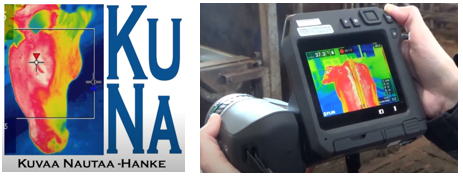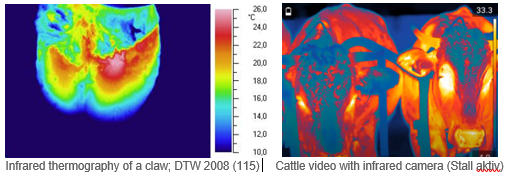
https://ec.europa.eu/eip/agriculture/en/find-connect/projects/bovine-beef-innovation-network-europe
Lameness is one of the main health and economic issues concerning dairy and beef cattle production systems. This multifactorial problem can have far-reaching consequences, including a reduction in feed intake and production performance. An early detection and thus early treatment of the trigger is useful in the case of lameness to prevent severe consequences. However, lameness detection in fattening cattle is not easy. The fact that fattening cattle are less seen in motion than, for example dairy cows makes the detection of lameness even more difficult. Infrared thermography could offer a solution here.
Infrared thermography has been shown to be useful in diagnosing hoof abnormalitites in cattle. As a non-invasive technique, it can be an effective method for diagnosing claw lesions at individual and herd level. A quick screening of the herd shows already differences in the concerning part of the body (see video below).
Infrared thermography can be used to identify subclinical pathological signs and inflammation before the disease becomes apparent. Research has shown that the temperature of the coronary ligament increases in the presence of claw horn lesions. The optimal compromise between sensitivity and specificity could be achieved without cleaning or lifting the feet.
Links:
Demonstration in Germany (FLI)
Demonstration in Belgium (ILVO)
Literature:
- Werema, C.W. (2019): The potential of infrared thermography for the detection of dairy cattle lameness https://www.ivis.org/library/iclr/lameness-ruminants-international-symposium-and-conference-japan-2019/potential-of-infrared-thermography-for-detection-of-dairy-cattle-lameness
- Redaelli, V. et al. (2013): Taking infrared images from bovine digit: new perspectives in lameness surveillance https://www.ivis.org/library/iclr/lameness-ruminants-international-symposium-and-conference-uk-2013/taking-infrared
- Alsaaod, M. (2013): Field study: Use of infrared thermography (IRT) as a non-invasive diagnostic tool for early detection of infectious hoof disorders in dairy cows https://de.scribd.com/document/209744579/A-Field-Trial-of-Infrared-Thermography-as-a-Non-Invasive-Diagnostic-Tool-for-Early-Detection-of-Digital-Dermatitis-in-Dairy-Cows
- Wood, S. (2013): Infrared Thermography for Lesion Monitoring in Cattle Lameness https://www.ivis.org/library/iclr/lameness-ruminants-international-symposium-and-conference-uk-2013/infrared
Impact:
- Socio-economic resilience: An infrared camera (borrowed or bought) will increase costs for equipment which have to be outweight by higher profit from not lame animals.
- Animal health and welfare: Animal health and welfare will definitely increase from this technique. Early detectet lamenesses will prevent the animals from pain.
- Production efficiency and meat quality: Average daily growth and carcass yield are higher in healthy animals, thus an easy check for claw health (before severe lamenesses are visible) can increase product efficiency.
- Environmental sustainability: Higher weight gain leads to a better product efficiency and to shorter fattening periods, which can positively affect environmental sustainability.
Other projects concerning the use of infrared thermography in animal husbandry:
https://kuna.savonia.fi/in-english
Salla Ruuska, Savonia University of Applied Sciences (Finland): Early detection makes early treatment possible, which means healthier cows and less money spent. However, the use of this technology is limited by the lack of practice-oriented information. The objective of KUVAA NAUTAA PROJECT is to develop a comprehensive information package on the use of thermography in cattle health care. These instructions are designed for farmers as well as for veterinarians, hoof trimmers and agricultural experts.
 Pictures from the KUVAA NAUTAA PROJECT
Pictures from the KUVAA NAUTAA PROJECT
